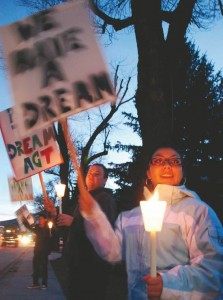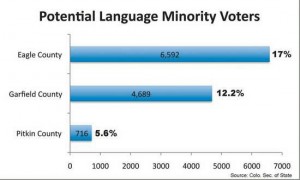Aspen Journalism is an independent nonprofit news organization.
Under the 1973 Voting Rights Act, areas with large Hispanic, Asian, American Indian and Alaskan native groups must provide bilingual voting materials and bilingual poll workers.
Ten Colorado counties already must publish bilingual materials: eight in Spanish, two in Navajo and Ute. After the 2010 census, 16 more counties are expected to be covered by the act, including the counties that make up the Roaring Fork Valley. Six more counties are within the margin of error.
“There’s no doubt about it,” said Garfield County Clerk Jean Alberico. “We’re going to be a covered county.” She said she’s just waiting for a phone call from the Justice Department to tell her when.
Jurisdictions become covered by the language minority provision of the Voting Rights Act when more than 5 percent of all voting age citizens are considered to be of limited English proficiency. Based on the latest census numbers, 17 percent of potential Eagle County voters, 12.2 percent of potential Garfield County voters and 5.6 percent of potential Pitkin County voters meet that standard.
While the overall Hispanic populations of those areas are much higher — Garfield and Eagle county are nearly one-third Hispanic and Pitkin is 9 percent Hispanic, according to the census — the potential voter numbers are based on estimates of voting-age citizens in the American Community Survey, the longer census forms that some households received.
Colorado as a whole will also likely be covered by the Voting Rights Act, Alberico said, forcing any state question on the ballot to be run in both Spanish and English. Towns and taxing districts would also have to provide bilingual language for their ballot issues.
Alberico said it’s still not clear if all voters must receive the ballot in both languages — making for a possibly cumbersome and confusing ballot and a costlier mailing — or if voters may choose the language.
The challenge, she said, will be finding bilingual election judges. “That means we’re going to be needing to reach out to different groups in the communities,” Alberico said.
Parties are facing the same dilemma. Democrats see Latinos, who helped push President Obama to victory in 2008, as a pool of largely untapped voters in this region. Republicans see them as value-based voters they could lure.
Garfield County Democrats have formed a new outreach committee to try to recruit both younger voters and Latino voters.
“If Democrats, or people of good will anywhere, don’t embrace this it’s a terrific loss to our community,” said Jack Real, the chairman of the county party. He said he saw the potential in Latino voters two years ago while campaigning for Obama. He signed up some 11 Latino voters, some of them new citizens who spoke little English but wanted to vote for Obama, he said.
Garfield County Republicans Chairman Ron Roesener said his party has also tried to reach Latinos, but on an individual basis.
“It’s been one-on-one,” Roesener said. “I haven’t been able to get enough that spoke English and were legals together. I don’t mean that to sound politically incorrect or improper but that’s been my experience. I’ve stopped some at the grocery story here, the Clark’s Market (in Battlement Mesa). Almost everyone I stopped, the kids speak English, the parents don’t.”
Glenwood Springs City Councilman Steve Bershenyi, a Democrat, said his unsuccessful county commissioner campaign tried too late to reach Hispanic voters two years ago. Had he done it earlier, he said, he might have closed the 350-vote margin that put him behind Commissioner John Martin, a Republican.
He said his organization held meet-and-greets with Latinos to woo voters, but it should have done more, and sooner.
“One of the things we as a party have to do is to make sure we are absolutely certain that we have a policy in place, not only to reach out to the Hispanic community but to make sure they’re included in the process up to and including candidates,” Bershenyi said.
Both parties, overwhelmingly white, say they’ve seen growing numbers of Hispanics at their events, but it’s been slow. Democrats are eying Latino high school- and college-aged students, young people who often were born here, even if their parents weren’t. In El Jebel, Carbondale, Glenwood Springs and Parachute, white children under 18 are in the minority.
“On our Facebook page we’ve got 50 people on there and maybe four or five who I guess are Hispanic,” said Bryan Fleming, president of the new Young Republicans of Garfield County group.
Fleming said he had never considered targeting Hispanics as a specific group.
“Personally, in a generalization, I would like to have our Hispanic folks involved just in that I think they fall more in line with Republican values,” he said.



